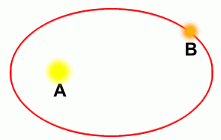  Alpha Centauri is the nearest star to us, not counting the Sun. Its distance away, quite near on the astronomic scale, is a mere 4.3 light years. Alpha Centauri is the nearest star to us, not counting the Sun. Its distance away, quite near on the astronomic scale, is a mere 4.3 light years.But a light year is how far light travels in one year. At a speed of 300,000 kilometres every second, that's a long way! Alpha Centauri is about 41,000,000,000,000 kilometres from us! The fastest spacecraft we've ever sent into the Solar System, if it kept going towards Alpha Centauri, would take over 100,000 years to get there! An analogy: if our Sun were a basketball and the Earth were a pea, Alpha Centauri would be another basketball about 8000 kilometres away. That's how far apart stars are in our part of our galaxy. Actually, Alpha Centauri isn't a single star at all. It's a system of three stars, called Alpha Centauri A, B, and C. Centauri A is a star much like our own Sun; Centauri B orbits around it. Centauri C, (sometimes called Proxima Centauri) orbits around both of them.  Alpha Centauri A & B form what's called a close binary system, with B orbiting A at an average distance of only 23 times the Earth-Sun distance, completing an orbit every 80 years. Proxima Centauri orbits well outside them, at a distance of 13,000 times the Earth-Sun distance; as a result, it's actually the closest of the three to Earth, at 4.2 light years from Earth, or 39,900,000,000,000 km. Alpha Centauri A & B form what's called a close binary system, with B orbiting A at an average distance of only 23 times the Earth-Sun distance, completing an orbit every 80 years. Proxima Centauri orbits well outside them, at a distance of 13,000 times the Earth-Sun distance; as a result, it's actually the closest of the three to Earth, at 4.2 light years from Earth, or 39,900,000,000,000 km. The Alpha Centauri system is not visible in most of the northern hemisphere; in the south, Alpha Centauri A is the brightest star in the constellation Centaurus and is the fourth brightest in the night sky. (Sirius is the brightest star, even thought it is more than twice as far away). Alpha Centauri A is the same type of star as our Sun, a spectral type G2 star, with the same colour and temperature as our sun. This has caused many scientists to speculate that it might contain planets that harbour life. Alpha Centauri B is a cooler orange star with a spectral type K1. Proxima Centauri is a dim red dwarf with a spectral type M5 ... much fainter, cooler, and smaller than our Sun. Proxima is so faint that astronomers didn't discover it until 1915. Because Alpha Centauri A is a star much like our own Sun, we know it is relatively old and stable, so there is a possibility that planets may have formed around it and life developed, as it did here. It formed from the same cloud of gas and dust as our Sun did, so the chemical composition of any planets should be similar. The difficulty lies in the fact that Alpha Centauri is actually a triple-star system. Proxima Centauri is too far away from the others and too small for it to have much of an effect on any planets orbiting A or B. But those two stars are quite close together; the changing gravitational pull from one star or the other might cause the orbits of any planets around one or both of them to be unstable. If the distance of a planet from either A or B exceeds about one fifth of the closest approach of the other star, then no stable planet orbit is possible. This limits the region in which planets can successfully form to about twice the Earth-Sun distance. This means that both Alpha Centauri A and B might have one or two planets at a distance with enough warmth for water to be a liquid, and where orbits are stable. |